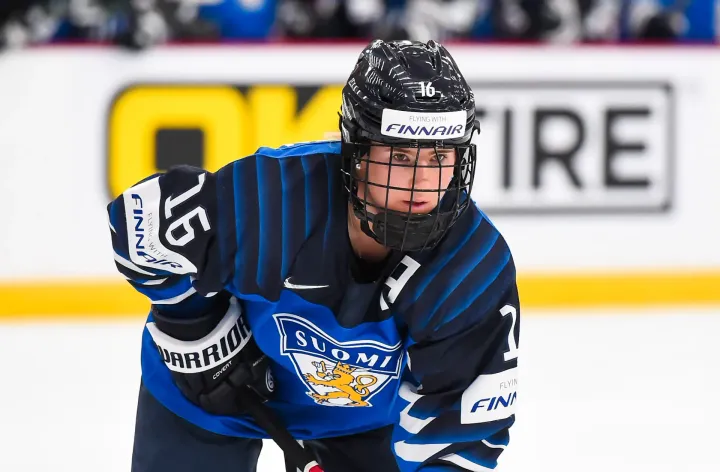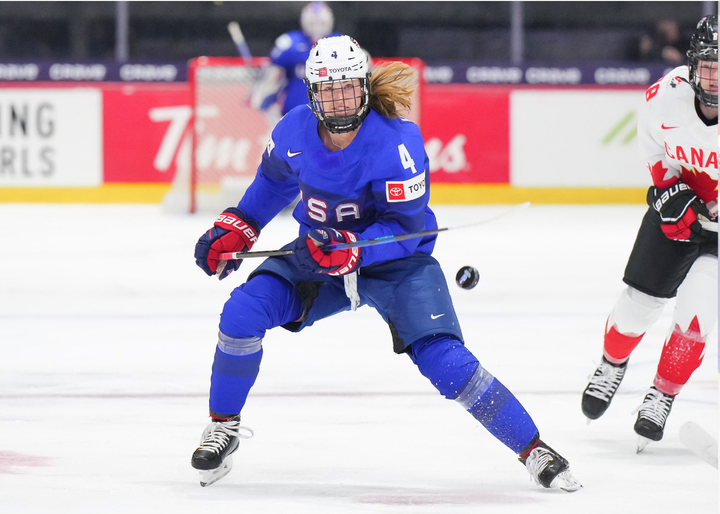Review: ‘Dare to Make History’ gives unique insight into what it means to dream big, on and off the ice
The book, co-authored by three-time Olympians Jocelyne Lamoureux-Davidson and Monique Lamoureux-Morando, is out on Feb. 23
It’s been just under two weeks since Monique Lamoureux-Morando and Jocelyne Lamoureux-Davidson announced their retirement from hockey, but they won’t be receding into the limelight just yet. Dare to Make History: Chasing a Dream and Fighting for Equity, the book they co-authored, hits shelves this week.
In it, they chronicle their journey from playing pond hockey with their brothers and neighborhood friends in Grand Forks to winning Olympic gold medals in 2018, and every setback, achievement, and lesson learned along the way.
The twins set out to write this book—their first—after the 2018 Winter Olympics. They said a few people threw out the idea to them because they have such a unique story as elite athletes and twins, and also because of everything the U.S. Women’s National Team together had accomplished in that last Olympic cycle, both on and off the ice.
That’s ultimately where the finished book shines. It’s a comprehensive, exciting account of their careers that also lends valuable insight into how the sport of women’s hockey has grown and shifted over that timespan. And it’s told by two people who not only witnessed that growth, but put in so much effort themselves to help foster it.
Thanks to the way they chose to narrate Dare to Make History, they’re able to convey these stories in a pretty unique way. Rather than write it from their collective perspective, they wrote sections of each chapter from their individual perspectives.
“I think one of the biggest challenges from the outset for us was figuring out how to use our voices, because we didn’t want it to all be ‘we’ and ‘us’,” Lamoureux-Morando said. “So it was figuring out a way to go back and forth between our voices that flowed nicely and wasn’t too choppy, and I think once we got that rhythm down, that made the process a lot easier.”
This approach benefited them as writers, allowing them to explore their own experiences and dive into what matters to them individually, but it also gives some added value to readers. The reader is in conversation with the text, as with any book, but the twins are also in conversation with each other, creating an extra layer of dialogue for the reader to tap into.
While the book contains its fair share of action-packed hockey stories, what’s perhaps most impressive about the twins’ storytelling is how they’re able to push the scope far beyond that. Their journey as hockey players and elite athletes is at the core, but it touches on so much more: mental health, personal relationships and family ties, and issues related to labor and equity in the women’s sports world.
And for as many highlight-reel moments as they have to document from their playing days, they also offer an honest, firsthand perspective of some of the toughest moments of their careers, including a triple-overtime playoff loss in their last college game, and the blown 2-0 lead against Canada in the 2014 Olympic gold medal game.
This gives a poignant look into the many stumbling blocks and setbacks elite athletes face, even when, like the Lamoureuxs, they’ve had incredibly successful careers. But, as they argue throughout Dare to Make History, success is never just about the wins and high points; instead, it’s a culmination of the highs and the lows, the bonds forged along the way, and the purpose to be found in moving ahead even after a heart-breaking loss.
As three-time Olympians, Lamoureux-Davidson and Lamoureux-Morando have gone through three Olympic centralization periods with the national team. Centralization is often a grueling, emotionally trying process for any player. Importantly, Monique and Jocelyne took some time to highlight this in the book, shedding light on some of the more difficult moments both in the lead-up to the 2014 Olympics and the 2018 Olympics.
“What people see [at the Olympics], they see you play for two weeks out of every four years. So they see the absolute tip of the iceberg. They don’t see everything else that goes on before that and leading up to that. So I think it’s important to portray it as a realistic picture and what you went through as a team, what you went through as individuals,” Lamoureux-Morando said. “If all we ever did was paint perfect pictures of everything, we could—because we could do that in certain aspects and make it sound like it was great—but no one wants to hear about how everything was perfect and great, because that’s just not reality.”
We’re also treated to an up-close-and-personal look into the fight for equitable treatment and support from USA Hockey, the governing body for both the men’s and women’s national teams. Jocelyne, Monique, and several other U.S. Women’s National Team veterans were at the forefront of this movement and the ensuing boycott that took place in 2017.
They give eye-opening testimonials on what it was like to spark those difficult conversations and eventually make the decision to boycott the 2017 Women’s World Championship. It was an exhausting and ultimately fulfilling process, and there are no better players to tell the story than these two, who came of age within the USA Hockey ranks when the women’s program was so often relegated to the back-burner. While the issues may have come to a head publicly in 2017, the players were dealing with them long beforehand.
“If all we ever did was paint perfect pictures of everything, we could—because we could do that in certain aspects and make it sound like it was great—but no one wants to hear about how everything was perfect and great, because that’s just not reality.” - Lamoureux-Morando
In one chapter, Lamoureux-Morando explains how the women were initially left out of the commemorative jersey design for the 2014 Olympics:
The most powerful moment of the book, to me, comes as they’re explaining the great lengths the national team players went to organize with their fellow pool players, college players, and others to keep the 2017 boycott going. To their knowledge, not a single player said yes to USA Hockey’s request to join the team; virtually every eligible adult women’s hockey player in the U.S. stood with them.
“We’ve talked about it and reflected on it and the magnitude of that two weeks and what that meant,” Lamoureux-Davidson said. “I think that’s why we’re so proud of our team and the program, but then you think about how amazing it is that we had that much support. And I think we had that much support because what we were doing was the right thing. If there was any question that we were trying to be selfish, or greedy, we would have been replaced. Players would have offered, and willingly offered, to take our place. I think that’s what’s so powerful about what we were able to accomplish.”
The twins have never been shy throughout their career about calling out things that need to be improved, particularly when it comes to gender inequities and unequal opportunities within the USA Hockey ranks. They offer up the same critiques and observations throughout the book, whether it’s a coaching decision they disagreed with on the ice or a time when they felt the team wasn’t getting fair treatment off of it.
Lamoureux-Davidson says that boldness comes partly from watching their brothers and other friends play professional hockey in leagues like the NHL, and having a deeper understanding of how things should be run.
“We grew up in a house where we got what our brothers got, we got the same opportunities that our brothers got, and not for any other reason than because our parents were providing equal opportunity for us within our family,” Lamoureux-Davidson said. “But when you get into environments where that’s not the case—and everyone’s talking about it, not just the two of us—it’s like ‘Well, what can we do? What’s going to be done?’ I think we’re just comfortable enough and confident enough to point those things out.
“These characteristics—and me probably more so than Monique—in different instances has gotten me in trouble because people don’t always like to hear the truth. But I think that’s where our stubbornness and opinions come from is, if everyone’s kind of talking about it, at what point do you do something about it?”
Related
Reflecting on two of women’s hockey’s best: A final farewell to Jocelyne and Monique Lamoureux
There are some deeply personal moments in the book as well. In one instance, Lamoureux-Morando shares the story of her first marriage and subsequent divorce—not an easy subject to speak about, let alone write about in such a public way for anybody to read.
“It kind of goes back to what I said before: you don’t want to paint a picture that your whole life has been perfect, and mine certainly has not been that,” Lamoureux-Morando said. “That was such a big part of my life when that happened, and so much changed for me and my perspective changed and I grew so much as a person and matured as a person, that I felt like I had to put that in there, even though it’s not something I love to talk about.”
It’s this candor, in part, that lends so much credence to the rest of the stories they tell in Dare to Make History. While they’re clear that they’re writing solely from their perspective, that perspective is an honest, transparent one. It invites readers to buy into the stories and messages written throughout the book, and in turn, to reflect on their own experiences and believe a little more in their capacity to push boundaries and create change.
Throughout the book, Lamoureux-Morando and Lamoureux-Davidson detail what it was like growing up in a family with four older brothers—and isn’t hard to see how they grew into players known for their intensity and rough-and-tumble nature. They also share plenty of lessons that were passed down from their parents in regards to sports.
But from chapter to chapter, you can also see how big an impact their parents’ philosophy had on the rest of their lives, eventually driving them to not only find ways to help out in their community but to start the Monique and Jocelyne Lamoureux Foundation.
That’s one of the central messages that they believe can inspire a much wider audience, whether the reader is an athlete or parent or somebody completely removed from the sports world.
“We talked about our foundation and kind of along the way the lessons that we weave throughout the book that we learned from our parents,” Lamoureux-Morando said. “Just being a good person, making a difference, having a positive impact on people, while also chasing your dream and being elite athletes—one doesn’t have to go without the other. You can do both.”
Dare to Make History: Chasing a Dream and Fighting for Equity is out on Feb. 23.





Comments ()